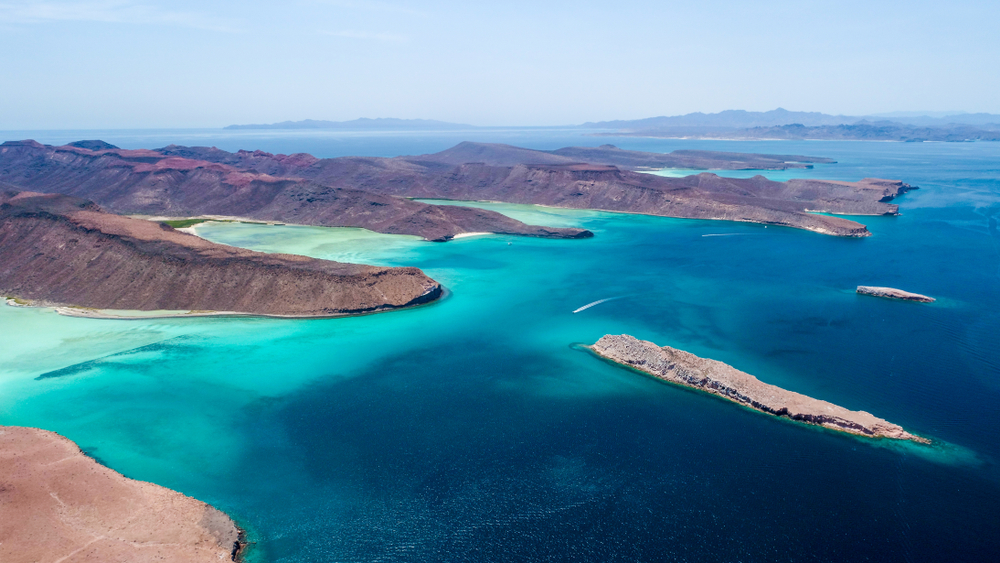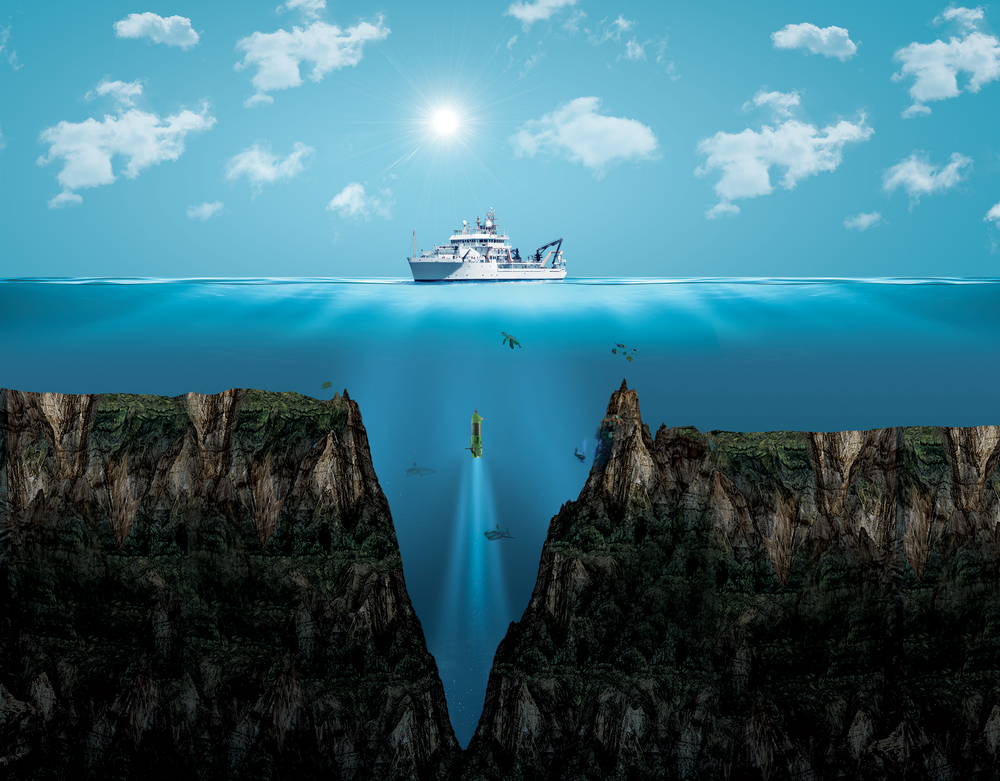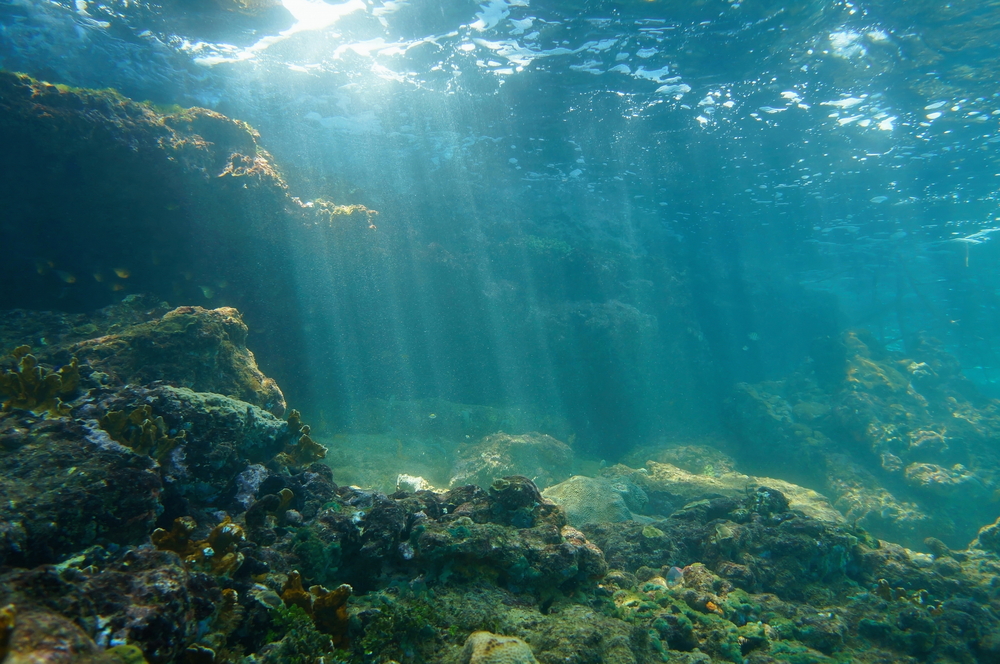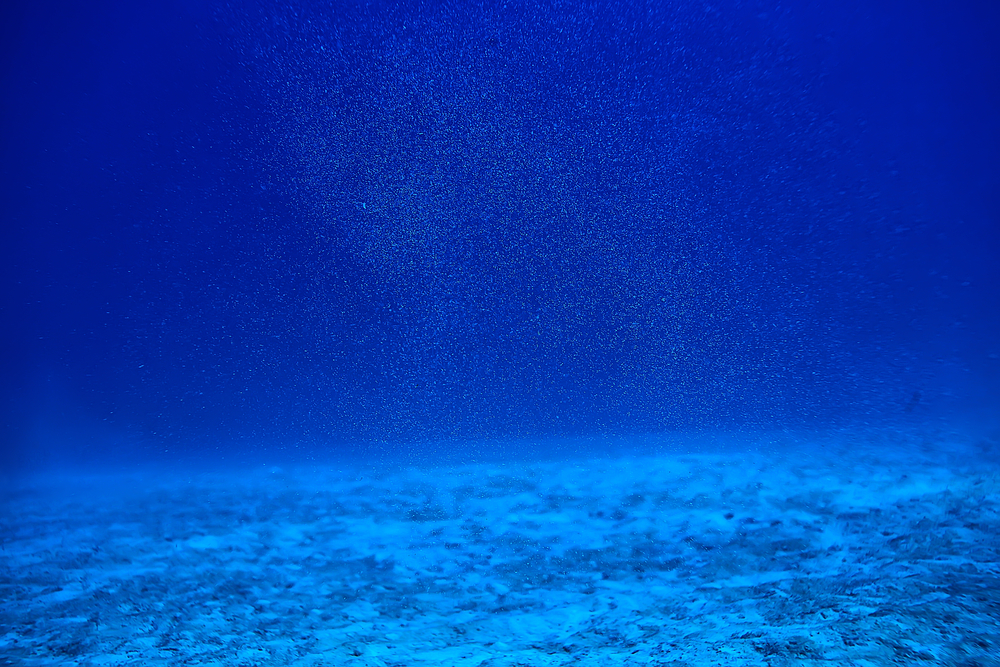How Much Gallons Of Water Is In The Ocean
The ocean has well-nigh 343 one thousand thousand trillion, or 343 quintillion gallons of water in it.
Although the Earth's oceans remain i of the most mysterious areas on the planet, scientists accept now adamant how deep they are and how much water they comprise.
Using satellites, scientists were able to guess these contempo measurements. The scientists worked out that the bounding main'south book is 0.3 billion mi3 (cubic miles). This number is lower than previous estimates of the ocean's book.
Scientists mapped and quantified its surface area and multiplied that by its boilerplate depth to work out the quantity of water in the ocean. (Technically speaking, there are four oceans, or maybe five, depending on who's counting.)
Tabular array of Contents
- How many oceans are officially recognized?
- The math of figuring out how much water is in the ocean
- Historical values of the book of the ocean
- Historical estimates of the quantity of h2o in the oceans weren't that far off
- Why practice estimates of the bounding main's volume keep decreasing?
- Measuring the bounding main's features with satellites
- Fine-tuning the estimate of the volume of water in the ocean
- What are the geographical locations of water on Globe?
- How much of the world is covered by the bounding main?
- The water bike
- If all the Earth's h2o was put into bubbling…
- All the water in one big bubble
- Liquid freshwater bubble
- Lakes and rivers bubble
- Over, on, and within the World, water is ubiquitous
- Water in the Earth
- The location of water in and on the World: fast facts
- The earth's ocean factoids
- In quintillions of gallons, how much water does the sea hold?
- What'southward the ocean'southward average depth?
- How deep can the sturdiest ROV (remotely operated vehicle) get down into the sea?
- What is the surface surface area of the sea?
- What percent of the seafloor is unexplored?
- What is the average temperature of hydrothermal vents?
- How deep is the body of water'south deepest signal?
- What is the pressure on the ocean flooring?
- What'due south the longest bounding main mountain range?
- What percentage of Globe's oxygen does the ocean generate?
How many oceans are officially recognized?

Let's get one thing clear. Although there is only one ocean globally, the vast body of saltwater that covers 71% of the Globe's surface is divided geographically into distinct regions. For historical, cultural, and scientific reasons, these boundaries have changed over time.
Historically, we've had four "oceans" named the Chill, Indian, Pacific, and Atlantic. The Southern (Antarctic) ocean is now recognized as the 5th ocean by some countries and the U.s.a.. The most well-known oceans are the Pacific, Atlantic, and Indian.
This makes the newest named ocean the Southern Ocean. The U.s.a. Board on Geographic Names recognizes it as the ocean that extends from Antarctica's coast to breadth lx° south.
In 2000, the IHO (International Hydrographic Organization) proposed the boundaries of this ocean. The boundaries accept not been ratified by the IHO considering not all countries concur with them.
The math of figuring out how much h2o is in the ocean
1.3 billion cubic kilometers. That's the judge amount of h2o that oceans are said to contain. Now, 1 kmiii = 1 x 109 liters (1 x xnine is a trillion.)
Therefore, at that place are approximately i,300 trillion, trillion liters of water in the oceans, which is 1.3 sextillion liters.
To calculate the volume of the sea in gallons, convert it from liters to gallons. There are 3.78541178 liters in a gallon. Multiplying 1.3 sextillion by 3.78541178, nosotros get 343,000,000,000,000,000,000 gallons, or thereabouts.
As noted at the start of this article, that'south 343 quintillion gallons.
Historical values of the book of the body of water

The depth estimate of 2.3 miles is approximately 69 to167 feet lower than previous estimates. Certain places in the ocean are far deeper than the average.
For case, the Mariana Trench is near 7 miles deep! Other areas, nonetheless, like the Mid-Atlantic Ridge, are shallower than the boilerplate depth.

Co-ordinate to the researchers, the whole world's ocean book is lower than previously estimated.
Information technology amounts to approximately five hundred times that of the Corking Lakes or five times the Gulf of Mexico'due south volume. Although it may seem like a lot, it is only 0.3 pct less than what was estimated 30 years agone.
Historical estimates of the quantity of water in the oceans weren't that far off
This small difference shows how precise fifty-fifty archaic measurement techniques were in estimating the volume of the bounding main.
For example, John Murray used lead weights to decide the ocean's book. This figure was calculated by dragging a rope from a transport and computing the ocean area.
Information technology is only 1.2 per centum more National Environmental Satellite, Data and Information Service (NOAA) geophysicists Charette and Walter H.F. Smith reported.
Echosounders were used by researchers to improve depth estimations starting in the 1920s. In mod times, Smith, along with others, pioneered satellites for bounding main volume calculations.
Why practise estimates of the sea's volume continue decreasing?

The trend towards a gradual lowering in book estimates does non mean that the ocean is losing water. Instead, nosotros are meliorate able to find formations like undersea mountain ranges that occupy space that would otherwise be occupied by h2o.
Satellite measurements show more mountainous and bumpier ocean bottoms than previously thought.
Measuring the ocean'due south features with satellites
Satellites don't really measure the bottom of the bounding main. Satellites mensurate the ocean's surface to see what is beneath. If a mount range is found under an ocean expanse, it volition cause the ocean's surface to bulge outward.
Smith stated that the satellite projection covered almost all of the oceans in the world. The exception was some Arctic areas, which are all the same covered by ice.
This new map shows the world's oceans in greater item, thereby giving united states of america a more than accurate moving picture of the sea'southward volume and shape.
Fine-tuning the estimate of the volume of water in the body of water
However, satellite measurements have some flaws as there is a problem with spatial resolution. We are measuring the sea surface, which is affected by mountains.
But nosotros encounter but huge mountains and merely in a blurred manner. This resolution is 15 times lower than our Mars and Moon maps.
According to the researchers, this means that more ship-based measurements will exist required to "fine-tune" satellite information. Ship-based sonar and other instruments accept only mapped x% of the World'southward ocean floor.
One expert noted gaps in "echo-sounding measurements as wide as New Jersey."
US Navy estimates suggest one ship would accept to spend two hundred years to map the depth of the entire body of water flooring with echosounders.
What are the geographical locations of water on Earth?
How much of the world is covered past the bounding main?
The Earth is watery, so how much water does this planet have? The oceans contain 96.five percentage of World's water, and the Earth'south surface is 71% covered by water.
In that location's also water vapor in the air to consider. It is in glaciers, lakes and rivers, ice caps, and groundwater similar soil moisture, aquifers, as well as in all of us and even our pets.
The h2o bike
Water never stays notwithstanding. The water cycle is responsible for the planet's abiding h2o supply moving from one place and i course to another. Without the water cycle, things would become pretty boring!
If all the Globe's water was put into bubbles…
All the water in 1 big bubble
If all the Globe's water could exist put into bubbles representing relative amounts of Earth water to its size, the h2o spheres would be surprisingly pocket-size.
That's because they actually are small relative to the Earth'due south size. The largest sphere would contain all the water on and in a higher place the World. Its book would be approximately 332,500,000 mithree, and its bore would be 860 miles.
Liquid freshwater bubble
There would be a smaller sphere with a book of well-nigh two,551,000 mi3 and a diameter measuring around 169.five miles. This water is freshwater, and we all utilise it every day. Nonetheless, a lot of it is underground, so humans cannot admission much of it.
Lakes and rivers bubble
This bubble is from all the rivers and lakes on the planet. These surface-water sources provide near of the water that people and other life on Globe demand daily.
This sphere has a volume of approximately 22,339 mi3. This sphere measures 34.nine miles in diameter. Imagine an most 35 mile-tall bubble. For comparison, Lake Michigan's boilerplate depth is only 300 anxiety.
Over, on, and inside the Earth, water is ubiquitous

97% of the water on Earth'southward surface is oceanic saline water. People take the freshwater resources they need to survive daily, including water that falls from the heaven and flows into rivers, streams, lakes, and groundwater.
Noticing where water is on the World's surface is relatively easy; for example, how rain fills up lakes and rivers. The unseen water beneath our feet is also vital to our lives.
How can we account for rivers flowing afterwards weeks without rain? How do we business relationship for the water that flows down our driveways when it isn't raining? Our water supply is far more complex than just surface water.
H2o in the Earth
Although only the World's surface water is credible to many people, the ground holds more than freshwater than what is available in free-flowing liquid class.
Some of the water that flows into rivers results from seepage from groundwater into riverbeds. Rainwater drains continuously into the ground and recharges footing reservoirs.
In turn, water in these ground sources continually recharges rivers through seepage.
Humans make use of both types of h2o, surface h2o and groundwater. The United states of america used approximately 275 billion gallons of surface h2o daily in 2010 and 79.iii million gallons of groundwater daily.
Groundwater is essential, even though it is used more than to provide drinking h2o and irrigate crops. However, surface water is vital considering it helps proceed lakes and rivers total.
It also supplies water to people living in areas where there is piddling water, like in the deserts of the west. People would rather exist playing golf in Palm Springs, California, than sand-surfing.
The location of h2o in and on the Earth: fast facts
- If all atmospheric water, groundwater, lakes and rivers, glaciers, ice caps, and oceans were put into a ball, the brawl would take a diameter of most 860 miles. This is about the aforementioned distance as Topeka, Kansas to Table salt Lake City, Utah. The brawl of all the water would have a total book of 332.5 one thousand thousand cubic miles (miiii). 1 mi3 is slightly more than than 1.1 trillion gallons.
- On boilerplate, at any moment, at that place is approximately 3100 mi3 of atmospheric h2o. Most of it is h2o vapor. It would only cover about ane inch if all of it savage every bit precipitation.
- The 48 contiguous states (lower 48 U.s.) receive approximately 4 mi3 precipitation each mean solar day.
- Approximately 280 mi3 of water evaporates or is absorbed into the temper every day.
- If all the water in the world were poured onto the United states of america contiguously, information technology would cover the state to a depth of approximately 107 miles.
- The ground holds more freshwater than rivers and lakes, which is why there is so much of it. The Globe holds more than ii,000,000 mithree of freshwater, about of it within one-half mile of the surface. The majority of this freshwater is found in the 7,000,000 mi3 of water held inside glaciers and icecaps located mainly in the polar regions, and Greenland.
The globe'south ocean factoids
In quintillions of gallons, how much water does the ocean hold?

A quintillion (Q) is this extraordinarily large number: 1,000,000,000,000,000,000 (ane followed by 18 zeros)!
In quintillions of gallons of water, the sea holds just a nudge over 350. Water infiltrates the body of water by rivers and melting ice and escapes from the ocean through evaporation.
What'southward the ocean's average depth?
The body of water's average depth is approximately 12,100 feet. This is a depth of about two.3 miles, and information technology is affected by the size and the historic period of the bounding main. The global ocean's deepest basin is in the Pacific.
How deep can the sturdiest ROV (remotely operated vehicle) go down into the ocean?
The Volkswagen ROV was built to withstand pressures at depths of 13,100ft. With more than vi,000 PSI (pounds per square foot of force), that's about 2.5 miles deep.
What is the surface expanse of the sea?
The bulk of the planet'due south water lies on its surface. The ocean is spread out beyond over 70% of the planet'due south surface. That equates to effectually 139 million miles of salty blue.
What pct of the seafloor is unexplored?
We accept Mars maps that are sharper and clearer than the maps we take of the sea. The GEBCO Seabed Project of the Japan Foundation is attempting to completely map Earth's ocean flooring past 2030.
So far, only a fifth of the entire ocean floor in the world has been mapped. This equates to having a map only twice Commonwealth of australia's size.
What is the average temperature of hydrothermal vents?

Hydrothermal vents are found in the Earth's seafloor and spew mineral-rich h2o – similar to geysers – that is powered by volcanoes.
Hydrothermal vents' temperatures tin accomplish a staggering 700°F, yet the seawater in the vent won't boil due to the tremendous pressure exerted by the miles of seawater pressing down on these special features.
How deep is the body of water's deepest indicate?
The deepest point lies at a depth greater than 35,000 feet below the surface of the body of water. It is a point along the Mariana Trench called "Challenger Deep."
What is the pressure level on the bounding main floor?
For every 33 feet in depth, the pressure increases past i atmosphere. The body of water reaches its greatest depth in the Mariana Trench.
There, the pressure exceeds 16,000 PSI. Humans, in comparison, feel a sea-level surface air pressure of only 14.seven PSI.
What'southward the longest ocean mountain range?
The planet'due south longest mount range goes on for over 40,000 miles. At that place'due south little hope of seeing this unique formation – called the Mid Ocean Ridge – because over ninety% of it is below water.
What pct of Earth'due south oxygen does the body of water generate?
In short, a lot. Photosynthetic microorganisms called phytoplankton transform sunlight into oxygen. They do this using photosynthesis just like state plants.
It is thought that some 50% to lxxx% of the Earth'due south oxygen resources originate in its oceans.
How Much Gallons Of Water Is In The Ocean,
Source: https://journeyz.co/how-many-gallons-water-in-the-ocean/
Posted by: ochoascang1935.blogspot.com







0 Response to "How Much Gallons Of Water Is In The Ocean"
Post a Comment